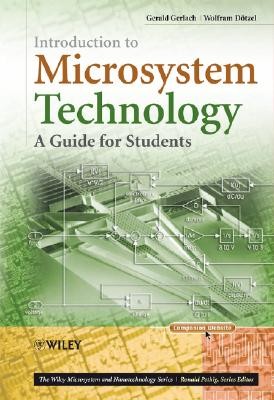
- We will send in 10–14 business days.
- Author: Gerlach
- Publisher: John Wiley & Sons
- ISBN-10: 0470058617
- ISBN-13: 9780470058619
- Format: 17.5 x 24.9 x 2.5 cm, hardcover
- Language: English
- SAVE -10% with code: EXTRA
Reviews
Description
Over half a century after the discovery of the piezoresistive effect, microsystem technology has experienced considerable developments. Expanding the opportunities of microelectronics to non-electronic systems, its number of application fields continues to increase. Microsensors are one of the most important fields, used in medical applications and micromechanics. Microfluidic systems are also a significant area, most commonly used in ink-jet printer heads.
This textbook focuses on the essentials of microsystems technology, providing a knowledgeable grounding and a clear path through this well-established scientific dicipline. With a methodical, student-orientated approach, Introduction to Microsystem Technology covers the following:
- microsystem materials (including silicon, polymers and thin films), and the scaling effects of going micro;
- fabrication techniques based on different material properties, descriptions of their limitations and functional and shape elements produced by these techniques;
- sensors and actuators based on elements such as mechanical, fluidic, and thermal (yaw rate sensor components are described);
- the influence of technology parameters on microsystem properties, asking, for example, when is the function of a microsystem device robust and safe?
The book presents problems at the end of each chapter so that you may test your understanding of the key concepts (full solutions for these are given on an accompanying website). Practical examples are included also, as well as case studies that enable a better understanding of the technology as a whole. With its extensive treatment on the fundamentals of microsystem technology, this book also serves as a compendium for engineers and technicians working with microsystem technology.
EXTRA 10 % discount with code: EXTRA
The promotion ends in 18d.08:15:47
The discount code is valid when purchasing from 10 €. Discounts do not stack.
- Author: Gerlach
- Publisher: John Wiley & Sons
- ISBN-10: 0470058617
- ISBN-13: 9780470058619
- Format: 17.5 x 24.9 x 2.5 cm, hardcover
- Language: English English
Over half a century after the discovery of the piezoresistive effect, microsystem technology has experienced considerable developments. Expanding the opportunities of microelectronics to non-electronic systems, its number of application fields continues to increase. Microsensors are one of the most important fields, used in medical applications and micromechanics. Microfluidic systems are also a significant area, most commonly used in ink-jet printer heads.
This textbook focuses on the essentials of microsystems technology, providing a knowledgeable grounding and a clear path through this well-established scientific dicipline. With a methodical, student-orientated approach, Introduction to Microsystem Technology covers the following:
- microsystem materials (including silicon, polymers and thin films), and the scaling effects of going micro;
- fabrication techniques based on different material properties, descriptions of their limitations and functional and shape elements produced by these techniques;
- sensors and actuators based on elements such as mechanical, fluidic, and thermal (yaw rate sensor components are described);
- the influence of technology parameters on microsystem properties, asking, for example, when is the function of a microsystem device robust and safe?
The book presents problems at the end of each chapter so that you may test your understanding of the key concepts (full solutions for these are given on an accompanying website). Practical examples are included also, as well as case studies that enable a better understanding of the technology as a whole. With its extensive treatment on the fundamentals of microsystem technology, this book also serves as a compendium for engineers and technicians working with microsystem technology.


Reviews